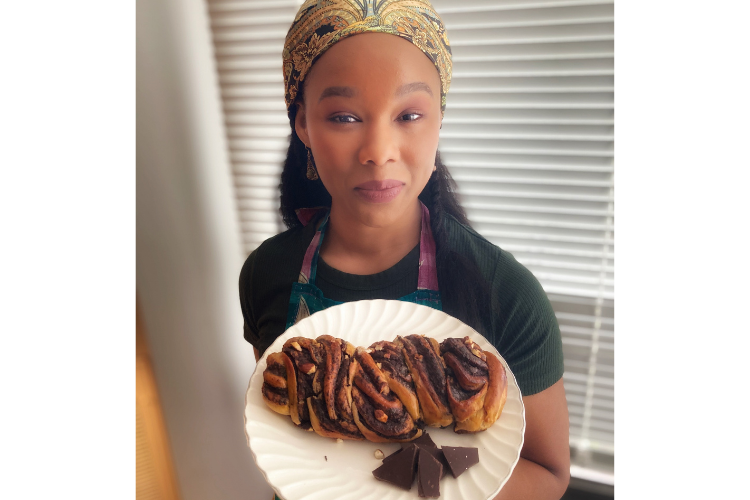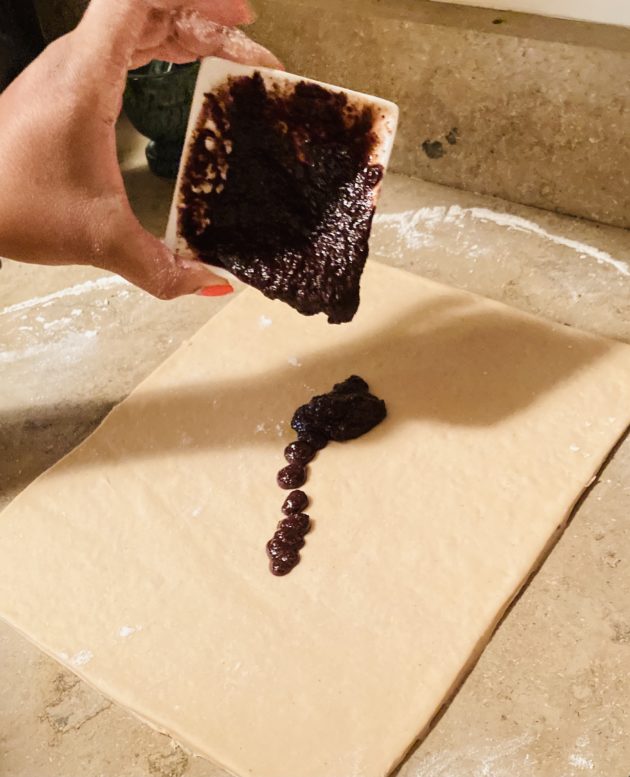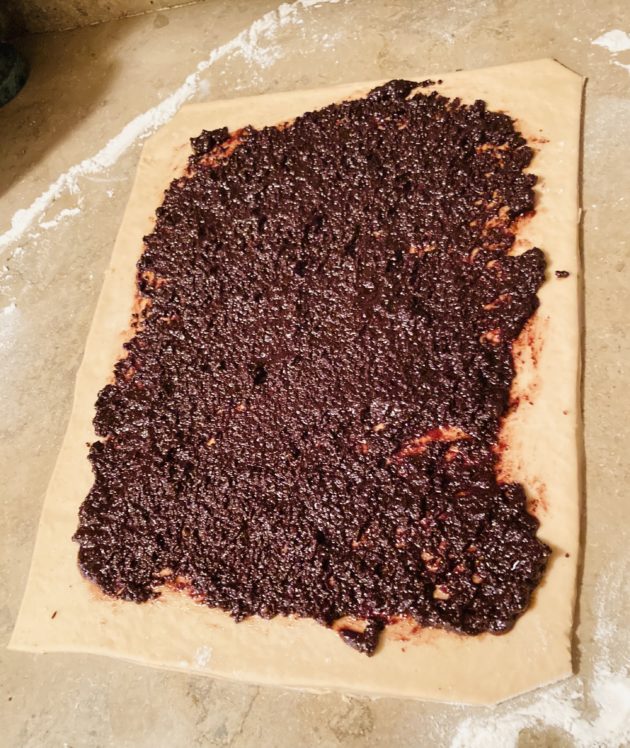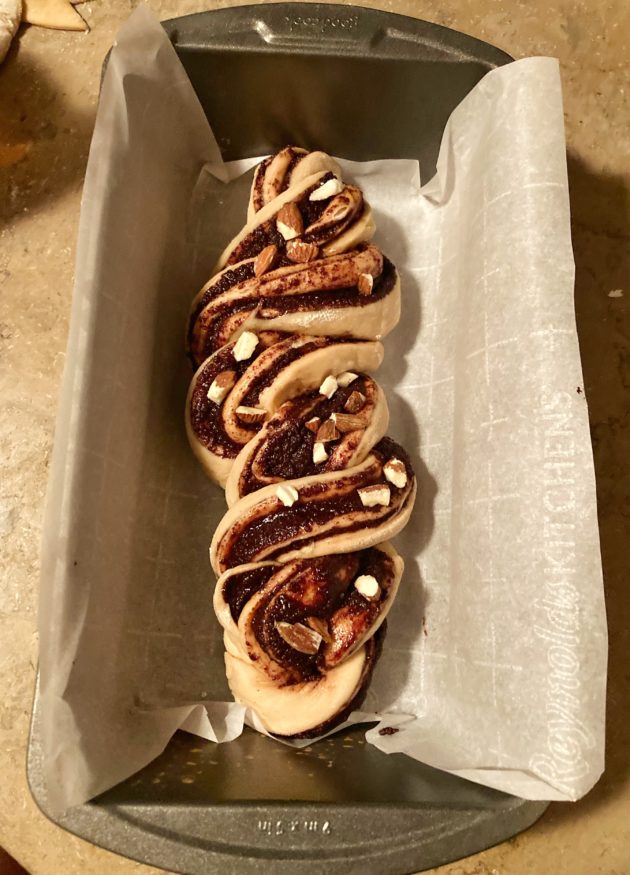
Therapeutic Powers of Babka
The thought of baking a bitter-sweet dark chocolate babka or any kind of challah bread is no cakewalk, (pun intended). But becomes second nature once you get the swing of the steps. I find baking bread a basic necessity–and an expression of love. My family enjoys every warm, gooey bite of any kind of bread I whip up in the kitchen. There’s also a therapeutic element to baking, specifically during the kneading process.
In the middle of my challah baking journey, I decided to take on a new baking challenge, babka. Soon, my internal baking motors began to rev with a fervent desire to not only bake babka, but to master the technique and design well.
As my baking experiments progressed, I played around with my own personal twists. A few delightfully hidden ingredients to wake up those sleeping adult papillae (taste buds)–6 tsp of schnapps (Cointreau Citrus Triple Sec- Liqueur), and 6 tsp of coffee liqueur (Mr. Black cold brew coffee liqueur). [No worries if spirits aren’t your thing, a little extra dark chocolate to ooze from sweet dough is more than enough to make up for it. I firmly believe there’s no such thing as adding “too much” chocolate.]
Tasting the schnapps and coffee liqueur in the babka calls back the memory of going to shul on Saturday mornings before the pandemic–members praying, laughing while enjoying a bit of schnapps in between Saturday morning services. Since the pandemic began, we haven’t been able to recreate those times at home. Those moments of togetherness among the Jewish community are what my family misses most.
Tasting the schnapps and coffee liqueur in the babka calls back the memory of going to shul on Saturday mornings before the pandemic
As we march ourselves courageously forward, how do we hold these memories close? For me, it’s baking– and eating– this babka: fluffy dark chocolate brioche-like dough, slightly glossy golden-brown crust, roasted coffee beans, and pecan nuts with a hint of coffee liqueur and schnapps. It warms the heart and home, especially when shared with others.
Schnapps Dark Chocolate Coffee Babka
My experience in baking challah certainly prepared me with the tools and knowledge of baking babka. With every step leading up to the twist or “braid” as some would call it, was pretty straightforward. Rolling out the dough, spreading the chocolate filling, once I cut the log into two parts facing it upwards, completely exposing the doughy chocolate layers to twist was a challenge but you can do it! This part in the process may come challenging or rather easy. Either way, try and try again. Happy baking!
As a guide, there are three points that are extremely crucial during the baking process:
- Quality ingredients: the brands and sourcing of various types of dry yeast, flour or eggs. I prefer King Arthur flour unbleached all-purpose
- Personal technique: whether you allow your dough to rise for a few hours or overnight; whether you prefer to use the table as a mixing place rather than in a mixing bowl.
- Time: the practice of baking challah bread simply takes measure and grit. In constructing a moistened, cake-like brioche, swathed around melted dark rich chocolate swirl and maybe crowned with roasted pecan nut crumbles (or chocolate chunks, your choice).
Baking Tools
- 2 medium-size mixing bowls
- 1 rolling pin
- 1 spatula
- 1 serrated knife
- Parchment paper
- 9-by-4” loaf pan
- Various measuring cups
- 1 large stainless steel whisk mixer
Ingredients
Babka Dough:
- 1 ½ cups of warm whole milk (non-dairy Oatly milk preferred)
- 3 cups of all-purpose flour
- 1 instant dry yeast (2 ¼t)
- ¼ cups of granulated brown sugar and organic honey
- 2 eggs/ 1 egg yolk
- 3tbsp olive oil
- 1 ½ tsps of fine kosher salt
- 6 tsp Cointreau Liqueur
- 1 tsps of vanilla extract
- 6 tsp Mr. Black coffee liqueur
- ½ cinnamon or nutmeg
- 7tbsp unsalted butter (at room temperature)
- ⅓ cups instant coffee powder
- 1 cup crushed almonds or pecan nuts
Chocolate Schnapps Filling:
- ½ cup (100g/3.5oz) of granulated brown sugar
- ⅔ cup (120g/4oz) Pecan Nuts (coarsely chopped) or chocolate chips
- 130g/4oz of Pasha Organic bittersweet dark chocolate (melted)
- 6 tsp Mr. Black coffee liqueur
- 5 tsp instant Vietnamese coffee
- ½ cup (120g/4oz) unsalted butter (at room temperature)
Brown Sugar Glaze:
- ⅓ cup water
- 1tsp vanilla extract
- 3tbsp of brown sugar
- 1tsp organic honey
- 1 tsp Mr. Black liqueur
Tips: To develop a particularly bitter-sweet and gooey dark chocolate, I prefer to mix 130g/4oz of dark chocolate chips melted, ½ cup (120g/4oz) of unsalted butter (or pareve if preferred) and 6 tsp of Mr. Black coffee liqueur on low heat in a saucepan. After spreading the concoction above, ⅓ cup (30 grams) cocoa powder, ⅓ of instant coffee, 1 cup (100g/ 3.5oz) of chopped pecan or roasted almonds, with a hint of cinnamon (optional).To preserve some time, use ⅓ cup (30g/1oz) Israeli Hashachar Ha’ole kosher dairy chocolate spread.
STEP ONE: Make the dough
- In a large bowl combine 1 ½ cups of warm whole milk (non-dairy Oatly milk preferred), 1 pack of active dry yeast and 2 tbsp of brown sugar and organic honey. Let sit for 5 minutes allowing the yeast to activate and foam.
- Beat in 2 eggs and 1 yolk, 3tbsp olive oil, 6 tsps of Cointreau, 1 tsps of fine kosher salt, and a hint of vanilla extract. Let sit for 5 minutes allowing the yeast to foam and activate.
- Combine with 4 cups of flour, whisk or use a stand mixer, each cup into the prepared mixture thoroughly as you go. Add stick (cubed) at room temperature unsalted butter. You will be left with a batch of sticky dough. Don’t fret.
- Lightly coat a second medium bowl with olive oil, then transfer the dough— place a damp cloth over the bowl and place it into the fridge. This cooling method will cultivate a stiffer consistency while your dough rises. Leave to rise and stiffen for half a day, preferably overnight.
STEP TWO: Kneading the dough by hand (6-9 minutes total):
- When your dough has risen, you should see little bubble pockets on its surface and the dough may have risen a few inches. If not, don’t worry. The dough will be firmer than it was before but not quite at the consistency as we need it to be. During the kneading process below flour is added. Here’s where a little arm exercise comes into play.
- Sprinkle flour to cover the entire workspace and coat your hands as well. This helps the dough not stick to the work surface and a little easier to manage.
- Place your powdered fingers at the top edges of the dough folding into the middle of the dough, towards yourself. Take the other edges and repeat until you have a ball-like shape.
- Add another step. Re-powder hands and surface if needed. This time, take edges with your fingertips, fold edges into the middle of the dough, then from there take the palm of your hand(s) pressing lightly down. As if the dough is sliding against and into itself and not into the work surface.The dough may absorb the flour on your hands and surface. Re-powder. Knead (pressing) dough into itself, not into the table. Repeat as needed. It can be a little tedious but stay patient, eventually your dough will conform.
- After 4 minutes of kneading the dough with flour, I prefer to rinse hands and start again with a clean work surface. This time, coating my hands and surface with a little olive oil instead of flour, knead the dough for 3 minutes. Then back to flour for the remaining 2 minutes. I find that a little oil makes the dough easier to work with. It may become a little messy but that’s ok. Then, maybe complete the kneading process with flour, leaving a ball of dough with a powdery finish.
- Allow your dough to rest (10 minutes) after handling it.
STEP THREE: Rolling it out
- Use flour as needed. Roll out your dough into a large rectangle that’s approximately 1 ½ inches thick and 15 inches wide. Don’t worry too much about precision.
- Then with a spatula, spread one or two layers of melted dark bitter-sweet chocolate and pecan crumbs on the surface of the dough.
- Starting with the side closest to you, carefully peel the edge of the dough off the work surface, rolling (with melted chocolate inside) it into a long cylinder.
STEP FOUR: Shape the babka
- Once you have a filling-rolled cylinder, use a serrated knife to slice your cylinder in half ”the long way”.
- Pulling the two halves apart, turn each long half cylinder ”inside up,” exposing rows of gooey chocolate and dough layers.
- Keeping both strands’ layers exposed until the twisting process is completed is difficult. Pinch and tuck the top ends closed, then cross your right strand over the left strand. Continue twisting both halves together three or four times until you reach the end. Pinch and tuck once again, yielding a twisted, elaborate design.
- Here’s a little tricky part but we can do it. Place one hand on each side of the loaf, simultaneously lifting the loaf upward and cradling as much of the bottom as possible. Then, with ease, lower your loaf into a 9-by-4” loaf pan, lined with parchment paper. Adjust loaf as needed.
STEP FIVE: Bake & glaze
- Whisk glaze ingredients together in a small bowl until completely blended.
- Glaze your babka before placing it into a preheated oven at 350 degrees.
- Bake for 30-35 minutes until bread’s crust is golden brown
- Sit your babka on a cooling rack until ready to eat. Babka also freezes well.
Aayisha Ruby Gold is a passionate stage and screen actor, theater director, and published author. She received her Bachelor of Arts at Columbia College Chicago in 2013. She spends most of her time as a superhuman mother and wife to her adorable 2-year-old son and husband.







